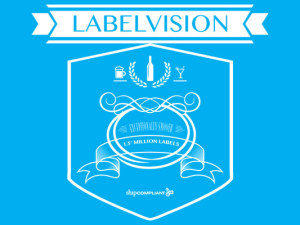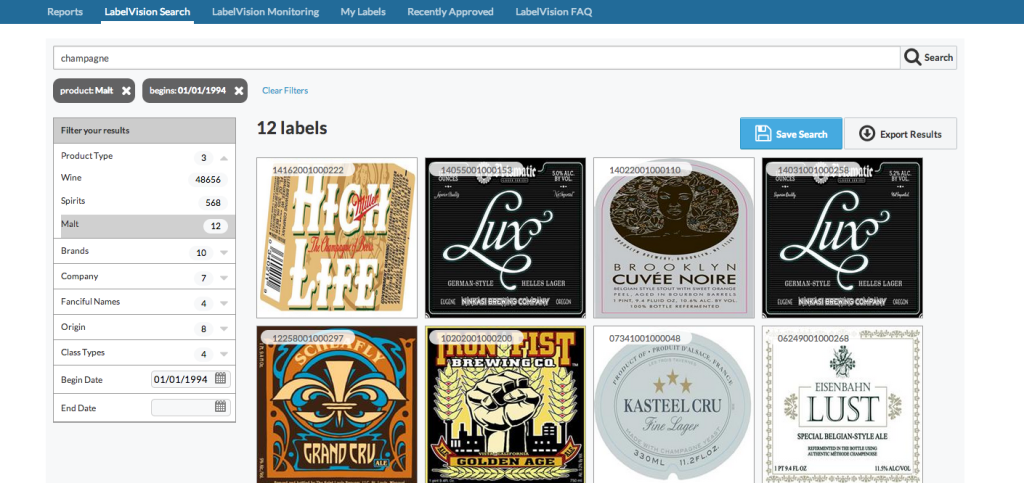 Last week, the folks at ShipCompliant officially rolled out a new service called LabelVision. To many in the wine, beer, or spirits industry, this new resource is a game changer. Instantly, we have access to over 1.5 million federally approved labels as far back as 20 years. To some, such a system may not seem much different from the TTB’s current public COLA database. To frequent users of the TTB system, however, LabelVision is a tremendous resource for many reasons. For one, LabelVision’s search capability significantly overpowers that of TTB’s public database: LabelVision allows a user to search a term that may appear on any part of a federally approved label.
Last week, the folks at ShipCompliant officially rolled out a new service called LabelVision. To many in the wine, beer, or spirits industry, this new resource is a game changer. Instantly, we have access to over 1.5 million federally approved labels as far back as 20 years. To some, such a system may not seem much different from the TTB’s current public COLA database. To frequent users of the TTB system, however, LabelVision is a tremendous resource for many reasons. For one, LabelVision’s search capability significantly overpowers that of TTB’s public database: LabelVision allows a user to search a term that may appear on any part of a federally approved label.
What does this mean, exactly? Well, for starters, instead of just searching the “Brand Name” or “Fanciful Name” of a federally approved label—which is currently the only portion of the actual, federally approved label text we can formally search through TTB’s public database—we can now search any part of an approved label’s text. This includes the paragraph of information a vintner may include about the vintage or the vineyard, as well as any stray text on the label. In the past, when using the public label database, I’ve often found its search capabilities limited and somewhat clunky. Many times, when assisting a client obtain a federal label approval, I’ve often wanted to search other portions of a label’s text than just the “Brand Name” or “Fanciful Name.” (What can be even more disheartening is that TTB tends to be very flexible with the actual brand name listed on the label, which means the applicant can be somewhat creative with what the wine’s brand name is listed as on the application, as long as such name appears on the label portion submitted to TTB as the true brand label.)
LabelVision changes all of this.
Another great aspect about LabelVision is that it serves as a mechanism for brand owners to patrol their registered trademarks and see if another company is potentially infringing upon the brand owner’s mark. This aspect reminds me a lot of my summer in Reims, in particular our trip to Le Comité Interprofessionnel du vin de Champagne (“CIVC”) in Épernay. During our visit, we met with the legal director of the CIVC, who recited many stories about how strictly the term “Champagne” is regulated—and not just on wine or other beverage products. While the CIVC looks at many other products (i.e., not restricted to alcohol) that may wrongfully use its protected geographical indication, a search tool like LabelVision could certainly come in handy for an organization (or brand owner) like the CIVC that seeks to protect a registered trademark or a geographical indication. As mentioned previously, LabelVision provides the ability to search all aspects of an approved label’s text, which can present results that TTB’s public label search simply overlooks or does not currently have the capability to search. (Note: Of course, just because an alcohol label is approved by the TTB does not necessarily guarantee that said label is used in commerce.)
In sum, ShipCompliant’s LabelVision is a great resource for alcohol beverage lawyers, compliance directors, and brand owners. It saves a significant amount of time, and offers great features like the ability to create alerts for new approvals matching certain terms. We’ll be using it a lot more going forward, and we certainly believe the ShipCompliant system is the future of alcohol beverage label searches.
For more information, view the ShipCompliant press release on LabelVision here or the ShipCompliant blog post here.
DISCLAIMER: This blog post is not intended as legal advice, and no attorney-client relationship results. Please consult your own attorney for legal advice.
